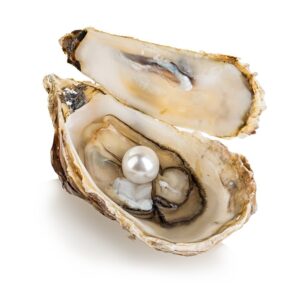Introduction
The June Birthstone, Pearl, originates from the depths of the oceans around the world. It is one of the most enchanting traditional gems with a unique, refined look and natural beauty. This “Queen of Gems” is the oldest gem and has been culturally significant for centuries in different ways and forms. They were traditionally given as wedding gifts. Ancients from the Middle East believed them to be teardrops fallen from heaven. One of the unique features of the pearl is that it is formed by a living creature. Due to this formation, pearls are available in a wide variety of shapes, sizes, and colours. The pearl is a biogenic gem that requires natural biological processes for its creation. For centuries now, pearls have been associated with purity, simplicity, and elegance.

History
The discovery of the pearl is estimated to be before written history, many thousands of years ago, while humans explored the seashore in search of food. Since then, the pearl has been one of the most sought-after and highly prized gems of all times. It holds a special place of significance in the religions and mythology of different cultures over time. Until the early 1900s, the pearl was considered a rare gem that was accessible only to the rich and elite. The ancient Egyptians considered the pearl their most highly prized possession and even chose to get buried with them. According to one of the myths and legends, Cleopatra dissolved a single pearl in a glass of wine and drank it to win over a wager with Mark Antony. She did this to prove to him that she could consume the wealth of an entire nation in just one meal!
During ancient times, the Romans considered pearls as an ultimate symbol of wealth. The Greeks held them in a position of high esteem for their unrivaled radiance and beauty. They also associated the pearls with love and marriage. During the Renaissance period, the European royal courts were awash in pearls. Many European countries passed a law that forbade anyone other than the nobility and royals to wear them. In 1916, a famous French jeweler Jacques Cartier bought his landmark store on New York’s Fifth Avenue by trading two pearl necklaces for the property. Gradually, with the advent and development of pearl cultivation, pearls became accessible, available, and affordable for all. They are a sign of grace, glory, and grandeur for people all over the world. They wear the pearl to adore its beauty as well as a means of self-expression.
Characteristics and Classification of Pearls
The pearl is a gem that is so versatile in its shapes and colours that it perfectly complements the skin tone and complexion of anyone who wears it. It is available in a wide variety of colours, ranging from white, grey, and beige to black. In addition, it is a gem that is available in almost any colour, either naturally or by dying. To have a perfect balance and combination of the right size, shape, and colour, the jeweller must scrutinize each pearl with an expert eye. The natural beauty of a pearl lies in its journey to becoming the best in shape, size, colour, and polish. Key factors affecting the size, shape, and colour of a pearl include the geographical location and cleanliness of the water and the type of oyster it is formed in.

Both natural and cultured pearls have a unique shape, size, colour, and polish. While the classic round white pearl is the most famous one, it is not the only one. A few different types of pearls include South Sea, Akoya, Tahitian, Hanadama, Fresh Water, Kesi, Cultured, and Blister Pearl.
Care and Cleaning of Pearls
The pearl is a comparatively softer gem and requires special care. Its quality could be maintained by storing it separately from the other gemstones to prevent scratching. Store your pearls in a cloth bag. Avoid storing them in a plastic bag as plastic emits a harmful chemical that damages the pearl quality. Clean your pearls with a damp cotton cloth after every use. Avoid direct contact with perfume, cosmetics, hairspray, ammonia, bleach, or any other chemicals.

Read more on the June Birthstone: http://iigindia.com/blogs/a-guide-to-buying-pearls/
Stay tuned for more knowledge on birthstones!

